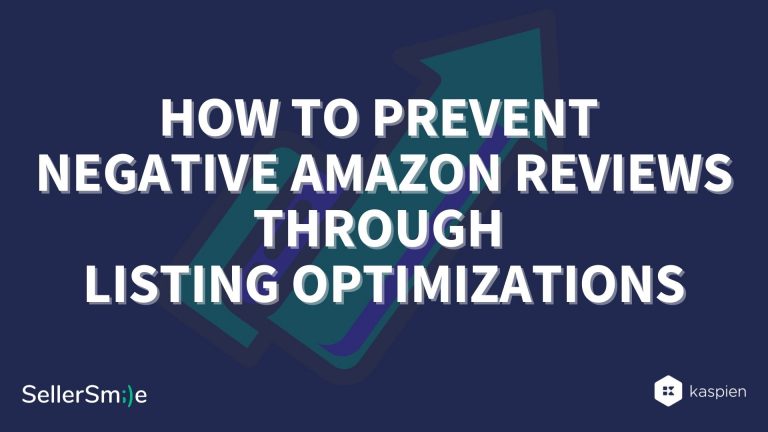Amazon reviews directly impact shopper conversion rates and product placement on the search engine results page (SERP), making them incredibly important for Amazon success. Strategies for gaining positive reviews often garner most of the attention, because, naturally, that’s what everyone wants. However negative reviews also deserve attention – specifically, how to lower the risk of getting negative Amazon reviews in the first place.
Why do customers leave negative Amazon reviews?
As any business owner can bemoan, customers are more likely to leave a review when they are upset than when they are satisfied. Customers are also more likely to leave a review if they are absolutely delighted, but even that audience has a lower tendency to leave reviews than shoppers who are displeased with their purchase.
And that right there is the core of the issue: When a product fails to meet your needs when you expected that it would, you feel a mixture of emotions, including feeling misled, betrayed, disappointed, stressed, and angry. Shoppers feel like they just wasted time and money, and that’s upsetting.
The root of negative Amazon reviews is when a product fails to meet the customer’s expectations.
Two ways Amazon listings set inaccurate expectations
So, why do shoppers’ expectations differ from the reality? In most cases, it’s because the information on the listing (or lack thereof) led them to believe untrue things about the product.
Misleading or untrue claims
A marketer’s job is to sell a product, and some marketers are willing to stretch the truth to achieve that goal. This is a mistake. Here’s why:
No amount of marketing will ever matter as much as a customer’s review. Why? Because shoppers trust other shoppers – who do not have a vested interest in selling the product – to provide more honest feedback than the seller. Customers can be your greatest advocates or your greatest detractors.
If your marketing makes claims your product cannot support, you’ll certainly win some new customers, but typically, that dries up quickly. As time goes on and the number of upset customers grows, their frustration and disappointment will drag down your sales.
Lack of information
Another common problem is a lack of information. Instead of the listing stretching the truth, it simply doesn’t tell shoppers what to expect, so customer’s expectations are based on hope more than facts. The fact that the shopper made the purchase with less-than-ideal information matters little when they can still leave a verified review.
How to prevent negative customer reviews on Amazon
If the source of negative Amazon reviews is inaccurate expectations, then the solution seems clear: Provide complete and accurate information. But, what are the best ways to do that?
Use multiple high-quality images
The first way shoppers engage with your listing is through images. After entering a search query, they are met with a wall of images and product titles, but it’s the image that catches the eye first, title second. So, step one is include multiple high-quality images that provide helpful information about the product.
Include images that show the product:
- from multiple angles
- in a natural setting
- next to a common object to help shoppers understand its size
- on a well-lit, white background to make color/texture easy to see
Generally, we recommend including 2-4 studio images (product on a white background) and 2-3 lifestyle images (product in use in a natural setting).
Include product demonstration videos
We also highly recommend including product demonstration videos, especially for products with moving pieces or complex parts. This could include board games, collapsible strollers, survival gear, etc. Such videos make it very clear how the product works, its size, the intended audience, special features, and more.
You can even hire influencers to create product reviews and product demonstration videos. In some cases, their fee will be less than or comparable to a freelancer or Creative Services studio, and you enjoy the added bonus of the influencer’s promotion.
Include product specs in the text
While images and videos provide helpful information at a glance, don’t neglect the text in the listing. The listing title, bullet points, and product information should be packed with important details, including any product specs, material information, sizing charts, weight, intended age range, special features, uses, care instructions, etc.
Conduct peer reviews
A final and easy best practice is to ask several people who are not familiar with the product to review the listing you created. After they review the listing, ask them what they know about the product. What questions do they still have? Did they misunderstand anything? Use their feedback to shore up any gaps in information or revise misleading claims.
How to delete Amazon reviews
Let’s say you’re reading this article because you’ve received some negative Amazon reviews. I hope it has proved helpful so far! If you’re hoping to discover if you can delete Amazon reviews, I’m afraid I have to say you’re probably out of luck.
Amazon will delete customer reviews when petitioned only if they can detect evidence that the review came from someone who did not buy the product or they suspect the review came from a paid reviewer. At the end of April 2021, Amazon suspended over a dozen major Chinese brands for participating in fake customer review schemes. These brands generate over $1 billion, suggesting that Amazon cracked down on them in part to send a message that fake review tactics will not be tolerated, no matter how big the brand.
Long story short, if your reviews are from an actual buyer, Amazon is probably not going to delete them. That holds true even if you update your product to correct any issues that resulted in negative reviews.
How to spot fake reviews on Amazon
In addition to knowing how to proactively prevent negative Amazon reviews, it can also be helpful to know how to spot fake reviews. This is useful for protecting yourself as a consumer, as well as spotting any unscrupulous practices by competitors.
Is the review verified?
To validate if a review is authentic, look for the “Verified” label next to the review. This isn’t a sure sign that the review is legitimate, but if the customer review is missing that piece, you have reason to start being suspicious.
Does the review parrot the listing?
You should also look at the average rating and the description provided in the review. If the review simply parrots the text from the listing itself, it may indicate that someone unfamiliar with the product was hired to write a fake review. They haven’t used the product, so they borrow from and paraphrase the product description.
Read the negative reviews
Read 1-star and 2-star reviews. Why are people dissatisfied with the product? Do they claim that other reviews are lying or misleading? Negative reviews are not necessarily more reliable than positive reviews, so take these with a grain of salt.
Use Amazon review checkers
Finally, you can use free tools like Review Meta to assess how reliable customer reviews are in a given listing.
How to Get Positive Amazon Reviews
Phew! We’ve talked a great deal about negative reviews and fake reviews, so let’s turn our attention to positive reviews.
Amazon retired the Early Reviewer Program in April 2021, making it trickier to get these oh-so-important reviews. However, all hope is not lost. In late 2020, Amazon updated their Buyer-Seller Messaging policies to explicitly allow post-purchase emails with customers. There are several other ways that Amazon sellers can increase the likelihood of receiving customer reviews while complying with Amazon’s requirements, but those deserve a blog post of their own.




